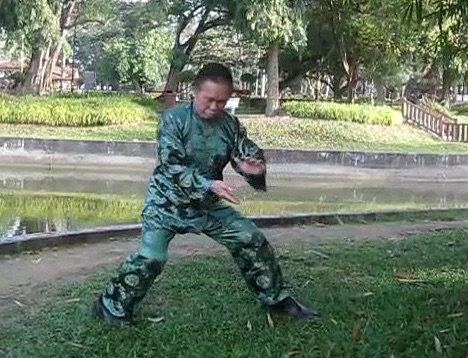FROM FLOWING FORCE TO CONSOLIDATED FORCE

The flowing force of Yang Style Taijiquan
Question
I would appreciate any insight you might have on the practice of Circle Walking with the upper body held in various postures and how it might compare to other methods of force training, such as simply holding the Green Dragon posture in circle walking, using the "secret" method of Walking the Circle for internal force by holding a posture for a period of time, then taking the next step along the circle to hold a posture for a period of time, and repeating until completing the circle, and the master's method of Baguazhang force training that you taught us at the Summer Camp.
— Frederick, USA
Answer
These are various methods to develop internal force. We are able to understand and benefit from these different methods because of our breadth and depth, which extend beyond Baguazhang, and from which we can draw inspiration and practice.
These different Baguazhang methods enable us to develop internal force that can have different proportion of flowing and consolidated force. The whole range of internal force in kungfu can extend from the soft, flowing force of Yang Style Taijiquan to the hard, consolidated force of Iron Wire.
Because both these styles as well as other styles of internal force, like Flower Set and Xingyiquan, are practiced in our school, we are able to draw from these styles to enrich our Baguazhang in a way that other Baguazhang schools may not be able to. This positive transfer of skills is enhanced by my understanding and practice of Dragon Strength.
A rough guideline showing the ratios of flowing force to consolidated force in various kungfu styles are as follows:
- Yang Style Taijiquan 90 - 10
- Wuzuquan 80 - 20
- Chen Style Taijiquan 70 - 30
- Dragon Strength 60 - 40
- Wudang Taijiquan 50 - 50
- Flower Set 40 - 60
- Baguazhang 40 - 60
- Praying Mantis 40 - 60
- Tantui 40 - 60
- Triple Stretch 30 - 70
- Wing Choon 20 - 80
- Xingyiquan 20 - 80
- Eagle Claw 20 - 80
- Choy-Li-Fatt 10 - 90
- Iron Wire 10 - 90
Please take not that the about listing is a rough guide, and there can be variation. Some Yang Style Taijiquan practitioners, for example, may have 20% or 30% of consolidated force instead of 10%. Generally only masters may have flowing force or consolidated force. Students may use physical momentum as in Aikido, or muscular strength as in Karate, and mistake it for flowing force and consolidated force.
By itself, i.e. without transference of learning from breadth and depth, Baguazhang force is about 40& flowing and 60% consolidated. A Baguazhang practitioner who has such force is probably a master or at an advanced level.
In our school, however, even students have internal force right at the start of their Baguazhang training, and due to the advantage of breadth and depth some may vary the proportion between flowing force and consolidated force.
A comparison of the various methods of Baguazhang force training using Circle Walking is as follows.
When the upper body is held in various postures, various types of consolidated force are developed according to the postures. When only the Green Dragon posture is used in Circle Walking, flowing force is developed, especially when various palm changes are performed at the end of a circle, like what you learned at the UK Summer Camp 2012.
As mentioned earlier, it is both safer and more effective to develop flowing force before consolidated force. If a practitioner starts straight away with consolidating force, the risk of causing energy blockage is higher. If he starts with flowing force, even when he makes a same mistake, energy flow will clear away the blockage.
Before energy can be consolidated, it must be flowing. This is a fact many people may not know. Hence, our students, who start with chi flow, can develop the same amount of internal force in a month whereas other students would need a year. Understandably, other people may be angry at this statement, and call us arrogant. That is their problem, not ours.
Another fact many people may not know is that consolidated force is also flowing, but at a slow pace. If a practitioner locks up his energy, it becomes stagnant and forms muscles.
When a Baguazhang practitioner uses the secret method of Circle Walking holding the Green Dragon posture for some time, then walk the next step and hold the posture for some time until he completes the circle, he focuses on developing consolidated force, but ensures that it is also flowing. This method should be practiced only after he has developed flowing force using the mobile Circle Walking.
The master's method taught at the UK Summer Camp 2012 is a progression form this method of Stance Training in Circle Walking. It develops different types of internal force using various Eight Internal Palms, and at the same time ensures that force is flowing. It should be practice after Stance Training in Circle Walking.
Hence an effective progression of internal force training in Baguazhang is as follows:
- Mobile Circle Walking holding the Green Dragon posture.
- Stance Training using the Green Dragon posture in Circle Walking.
- Circle Walking using the Eight Internal Palms.
The third level may be performed at two stages -- mobile circle walking with the eight internal palms, and stance training in circle walking with the eight internal palms.
The above is taken from Question 7 November 2015 Part 3 of the Selection of Questions and Answers.
LINKS
Courses and Classes
